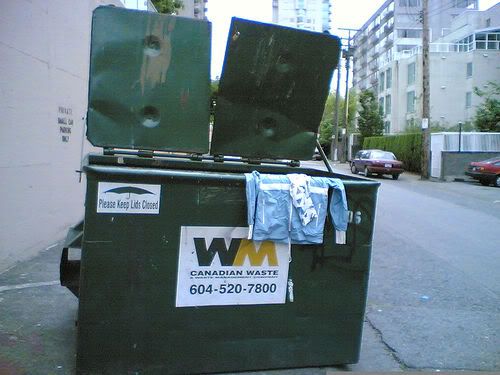Myth: Cloth diapers smell bad.
Truth: To me, cloth diapers don't smell HALF as bad as disposables. Think about it this way: when a disposable diaper is dirty, you roll it up and throw it in the trash. When a cloth diaper is dirty, you rinse it or soak it or whatever your method for dealing with dirties is. I rinse my dirty diapers out really well in the toilet, then put them to soak in Oxyclean and water, so they don't stink at all. And I don't use a diaper pail with a lid or anything, just a plastic trashcan. If you put them in a closed area (like a basket inside a closet), they won't smell so nice, but out in the open I've never had a problem.
Myth: There is too much start up cost to use cloth diapers.
Truth: Plain old pre-fold diapers from the store are about one dollar a piece. My mom made my diaper covers out of fleece remnants, but I recently found fleece for a dollar a yard at Wal-Mart. You can easily make up the cost of a dozen diapers and a couple of diaper covers in two weeks.
Myth: It's not worth cloth diapering if you have to pay to do your laundry.
Truth: It costs me a dollar a load to wash laundry. I have an indoor clothesline that I bought from
Lehmans, so I don't have to pay for a dryer. The cheapest size two diapers I can buy cost sixteen cents a piece. If I wash twenty diapers in a load, that's only five cents per diaper. If I replace only ten disposable diapers with cloth every day, I'm saving over a dollar per day. Even if I had to pay for a dryer, it would STILL come out cheaper. Do the math for your own circumstances and see what you come up with.
Myth: It's too much work to use cloth diapers if you don't have your own washing machine.
Truth: I used disposables the first two months or so for this very reason. But when I was having to wash clothes every other day anyway I realized one more load wouldn't hurt. Since then my laundry load has decreased, but I'm still using cloth diapers. Doodlebug rides in her sling while I carry diapers to the laundry room every morning. To me that's more convenient than having to go to the store and buy more disposable diapers.
My Cloth Diapering MethodI know when I was first learning how to use cloth I wanted to know lots of details on how to take care of them, but I had a hard time finding information. So here's what I do:
I have two dozen prefold diapers and one dozen flatfold diapers. There are lots of great videos on Youtube of how to use a prefold diaper if you need to learn. I'm not so good with the flatfolds, so I use two of those at a time to keep them from soaking through. I have seven fleece diaper covers my mom made for me. If you can't sew you can buy these online. And I have two Snappis to secure them instead of using pins.
I have a big laundry basket that gets carried from room to room with me as a my changing station. It contains diapers, a plastic trashcan, baby rags, and a coffee can filled with a squirt of baby soap and water (Make sure it has a lid on it!). I dip a baby rag in the soapy water to use as a wipe. Rags and wet diapers go in the little plastic trashcan. When the trashcan fills up I dump them in a different laundry basket (I just use the little can because it's more portable). I immediately rinse dirty diapers out in the toilet. Some people just dunk and flush, but I scrub them out pretty well. Then I put them to soak in a container of oxyclean and water. I've had a couple stain, but I just used more oxyclean the next time and the stains came right out. Diaper covers can be used more than once if they're not wet. *Note: Any container with water in it (wipe buckets, soaking buckets, etc.) should either have a secure lid or be up out of reach of babies and/or older children!*
I don't use bleach or anything to wash my diapers. I just use a detergent that has no perfumes or dyes, wash them in really hot water and hang them on the line. The good thing about having some prefolds and some flatfolds is that the flatfolds dry really fast so I can use them before the prefolds dry.
I was really surprised when I started cloth diapering how easy it is. It's really not at all inconvenient, and I love knowing that I'm doing so much for my daughter's future. I still have some disposables left, but I hate the thought of using them. I think filling a landfill is way more yucky than rinsing a dirty diaper.







